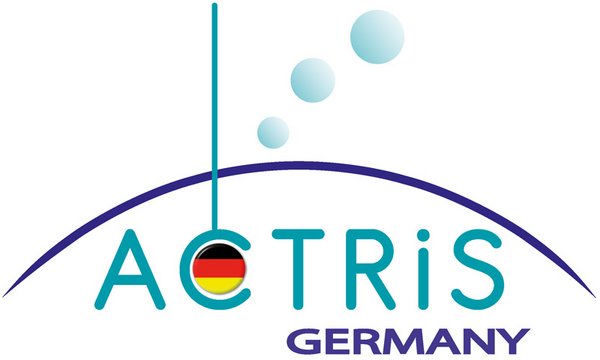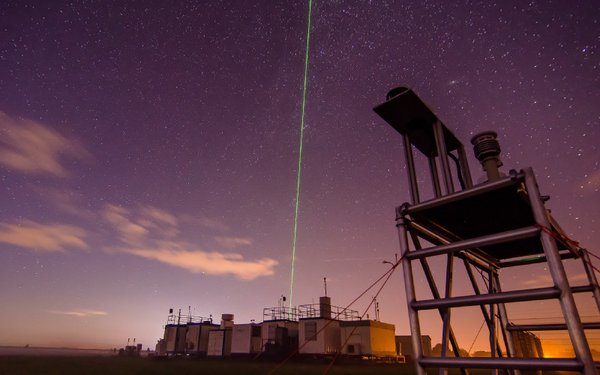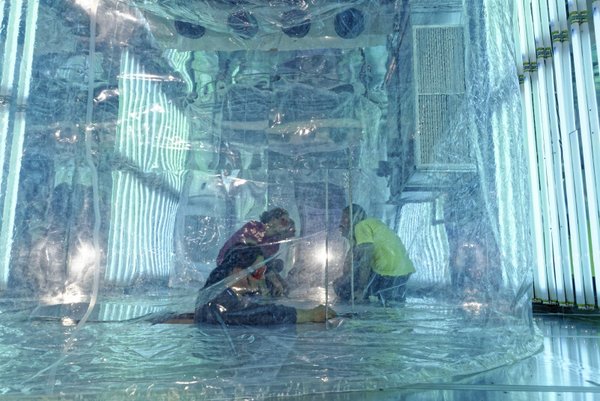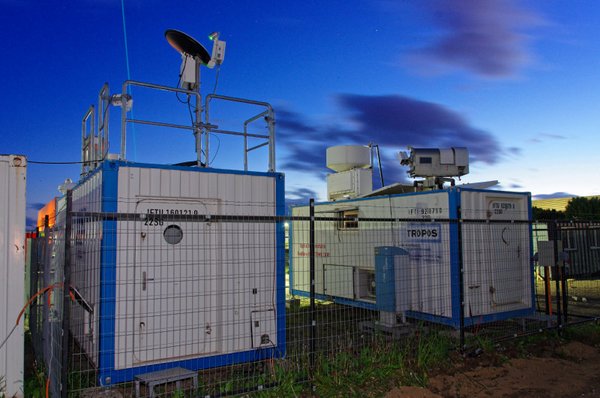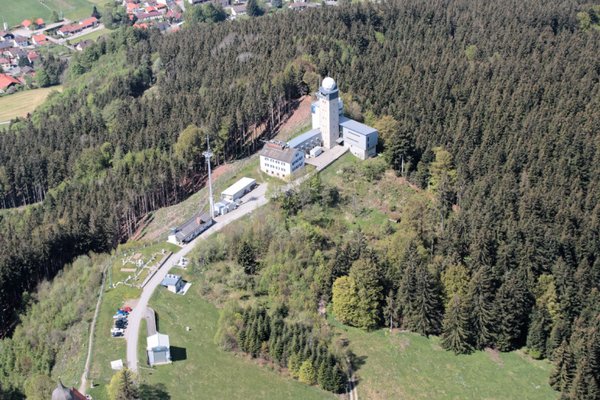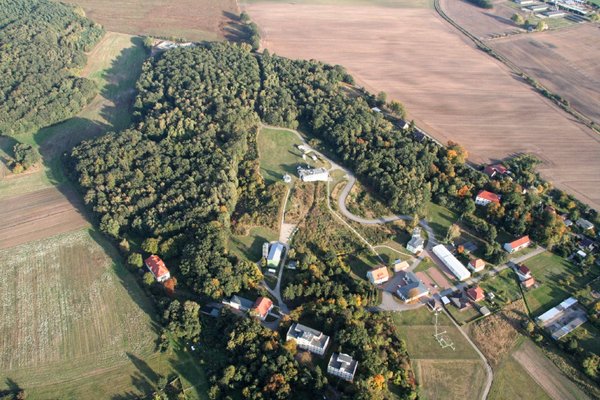Atmospheric research in Germany will be significantly expanded
Leipzig,
05.08.2021
National contribution to EU research infrastructure ACTRIS will enable better forecasts for air quality, weather, and climate in the future
Berlin/Leipzig. Germany is getting a new infrastructure for research on particulate matter, clouds, and trace gases. Distributed among eleven institutions, this German contribution to the EU research infrastructure ACTRIS will enable better forecasts for air quality, weather, and climate in the future. The Federal Ministry of Education and Research (BMBF) is funding the implementation of this infrastructure with a total of 86 million euros over the next eight years. Many players in German atmospheric research are working together in ACTRIS-D - including universities, non-university research institutions, and public authorities. The German part is coordinated by the Leibniz Institute for Tropospheric Research (TROPOS) in Leipzig.
ACTRIS will provide data on the short-lived constituents of the atmosphere from the ground to the stratosphere, helping to reduce uncertainties in the prediction of future climate, improve knowledge of climate feedback mechanisms, and assess measures to improve air quality and its impact on health and ecosystems.
ACTRIS is the fundamental European research infrastructure for short-lived atmospheric constituents, expanding Earth system observation and research and providing society with the knowledge to develop sustainable solutions. The acronym ACTRIS stands for Aerosol, Clouds and Trace Gases Research Infrastructure. These short-lived constituents of the atmosphere have a major influence on air quality and climate.
The short-lived climate drivers are usually only in the atmosphere for a few hours to weeks - in contrast to the long-lived greenhouse gases such as carbon dioxide or methane, which remain in the atmosphere for many years to decades. Therefore, much more is known about the effect of the long-lived greenhouse gases compared to the short-lived constituents, although these also have a significant influence on climate. For example, tiny particles suspended in air reflect sunlight and thermal radiation or serve as nuclei for the formation of cloud droplets and ice crystals, which affects precipitation formation. Humans influence the short-lived climate drivers through land use, transport, and energy production, which can have very different consequences: for example, soot particles contribute to warming, while sulphate and nitrate particles have a cooling effect. It is clear that all these factors have an impact on climate and must be taken into account in the predictions. However, the extent of the effects, some of which are very complex, has not yet been sufficiently investigated.
In addition to their impact on climate, short-lived constituents of the atmosphere also have a strong influence on air quality and thus on human health. Suspended particles, colloquially known as particulate matter, and short-lived trace gases such as nitrogen oxides lead to respiratory diseases and reduce life expectancy due to cardiovascular and respiratory diseases.
The impact of human activities on the atmosphere, from a single car to huge forest fires, can only be assessed if measurements are taken continuously and at many points distributed over a large area, because the atmosphere does not know any national borders. This is why the pan-European initiative ACTRIS was adopted to the European Roadmap for Research Infrastructures in 2016. In 2022, ACTRIS will start its long-term work in the legal form of an ERIC (European Research Infrastructure Consortium). With the adoption of the German contribution ACTRIS-D to the National Roadmap for Research Infrastructures in 2019, Germany has committed itself to participating in the European research infrastructure. The Federal Ministry of Education and Research (BMBF) is supporting this initiative as part of the "Research for Sustainability" (FONA) strategy. The BMBF has now begun funding the implementation of ACTRIS-D with an initial total budget of approximately 75 million euros. With these funds, numerous fixed and mobile measurement stations as well as laboratories and simulation chambers will be upgraded or newly constructed over the next five years. A second funding phase for the complete construction of ACTRIS-D is planned for the period 2026 to 2029. In addition, the Federal Ministry for the Environment, Nature Conservation and Nuclear Safety (BMU) will make an important contribution by providing long-term funding for the operation of service facilities such as the ACTRIS calibration centres.
Background
More than 100 research institutions from 22 countries are participating in ACTRIS. They have set up a network of more than 70 observatories across Europe, which is supplemented by stations in the polar regions, the tropics, and in Asia. In addition, there are 18 simulation chambers and laboratories in Europe in which processes in the atmosphere are simulated in experiments, as well as 17 mobile measurement platforms that can be deployed at different locations. ACTRIS aims to provide effective access to its data, resources, and services to a broad user community to enable high-quality Earth system research. Free and open access will benefit not only Europe as a centre of technology and science, but also environmental authorities and decision-makers, and ultimately citizens across Europe.
ACTRIS-D partner TROPOS:
The Leibniz Institute for Tropospheric Research (TROPOS) coordinates ACTRIS-D and participates with all three types of platforms:
The observational platforms include the global lidar network PollyNET, the German Ultrafine Aerosol Network (GUAN), the Melpitz research station near Torgau in Saxony, and the Cabo Verde Atmospheric Observatory (CVAO). With the Schmücke Cloud Observatory (SCO), there will also be a station in the Thuringian Forest in future that will be dedicated primarily to cloud research.
The exploratory platforms include the Atmospheric Chemistry Chamber (ACD-C) and the Cloud Laboratory (LACIS-T) at TROPOS in Leipzig. In addition to these stationary facilities, a number of mobile measurement platforms also play an important role in studying air quality and climate worldwide: The Leipzig Aerosol and Cloud Remote Observations System (LACROS) consists of several containers equipped with instruments and can be deployed worldwide. In the last three years, measurements were carried out with this facility at Punta Arenas, Chile, where, among other things, the smoke from the Australian forest fires in 2020 was observed. OCEANET is a mobile measurement platform that can travel worldwide on ships, like during the MOSAiC expedition on the research icebreaker Polarstern, to study the atmosphere above the oceans. OCEANET-2, a successor system for the new German research vessel Polarstern II, is already being planned. A measurement platform carried by a tethered balloon, which has also proven itself in the Arctic, will be upgraded as a mobile platform for aerosol and cloud research (ACME).
The central service facilities of ACTRIS will include three calibration centres located at TROPOS. The World Calibration Centre for Aerosol Physics (WCCAP)) ensures that aerosol measurement instruments will deliver high-quality data. The Calibration Centre for Organic Tracers (OGTAC CC) and the Centre for Cloud Water Chemistry (CCWaC) likewise contribute to the quality assurance of the measurement data.
The funding for ACTRIS-D will enable about 13 new positions for researchers at TROPOS over the next five years, as well as investments of around 20 million euros, and will thus make a significant contribution to strengthening Leipzig as a science centre and atmospheric and climate research made in Germany. Tilo Arnhold
Participating research institutions:
- Leibniz Institute for Tropospheric Research (TROPOS), Leipzig (lead) > https://www.tropos.de/
- Alfred Wegener Institute (AWI) - Helmholtz Centre for Polar and Marine Research > https://www.awi.de/
- University of Wuppertal (BUW) > https://www.uni-wuppertal.de/
- German Meteorological Service (DWD), Offenbach > https://www.dwd.de/
- Forschungszentrum Jülich (FZJ) > https://fz-juelich.de/
- Goethe University Frankfurt am Main > https://www.uni-frankfurt.de
- Karlsruhe Institute of Technology (KIT) > https://www.kit.edu /
- Ludwig-Maximilians-Universität Munich (LMU) > https://www.lmu.de/
- German Environment Agency (UBA), Dessau > https://www.umweltbundesamt.de/
- University of Bremen > https://www.uni-bremen.de
- University of Cologne > https://www.uni-koeln.de/
Links:
ACTRIS - the European Research Infrastructure for the observation of Aerosol, Clouds, and Trace Gases: https://www.actris.eu/
‘Research for Sustainability’ (FONA): https://www.fona.de/en/
Leibniz Roadmap for Research Infrastructures: https://www.leibniz-gemeinschaft.de/en/infrastructures/leibniz-roadmap-for-research-infrastructures.html
Contacts:
Dr. Ulla Wandinger (Coordinator of the German contribution to ACTRIS)
Dr. Markus Hermann (Coordinator for the implementation of the German calibration centres)
Phone +49-341-2717-7082, -7071
https://www.tropos.de/en/institute/about-us/employees/ulla-wandinger
https://www.tropos.de/en/institute/about-us/employees/markus-hermann
and
Prof. Dr. Andreas Macke
Director, Leibniz Institute for Tropospheric Research
Phone +49-341-2717-7060
https://www.tropos.de/en/institute/about-us/employees/andreas-macke
or
Tilo Arnhold
Public relations
Leibniz Institute for Tropospheric Research (TROPOS)
Phone +49-341-2717-7189
https://www.tropos.de/en/current-issues/press-releases
Note for the media:
High resolution photos can be found for media use free of charge if the source is acknowledged at:
https://owncloud.gwdg.de/index.php/s/xT01mtLoVyuoLF5
A picture gallery with photos of the EU partners & further material at:
https://www.actris.eu/outreach
The Leibniz-Institute for Tropospheric Research (TROPOS) is member of the Leibniz Association, which connects 96 independent research institutions that range in focus from the natural, engineering and environmental sciences via economics, spatial and social sciences to the humanities. Leibniz Institutes address issues of social, economic and ecological relevance. They conduct knowledge-driven and applied basic research, maintain scientific infrastructure and provide research-based services.
The Leibniz Association identifies focus areas for knowledge transfer to policy-makers, academia, business and the public. Leibniz institutions collaborate intensively with universities – in the form of “Leibniz ScienceCampi” (thematic partnerships between university and non-university research institutes), for example – as well as with industry and other partners at home and abroad.
They are subject to an independent evaluation procedure that is unparalleled in its transparency. Due to the importance of the institutions for the country as a whole, they are funded jointly by the Federation and the Länder, employing some 20,000 individuals, including 10,000 researchers.
The entire budget of all the institutes is approximately 1.9 billion Euros. They are financed jointly by the Federal Government and the Länder. The basic funding of the Leibniz Institute for Tropospheric Research (TROPOS) is therefore financed by the Federal Ministry of Education and Research (BMBF) and the Saxon State Ministry of Science and the Arts (SMWK). The Institute is co-financed with tax revenues on the basis of the budget approved by the Saxon State Parliament.
www.leibniz-gemeinschaft.de/en/home/
www.bmbf.de/en/index.html
https://www.smwk.sachsen.de/
